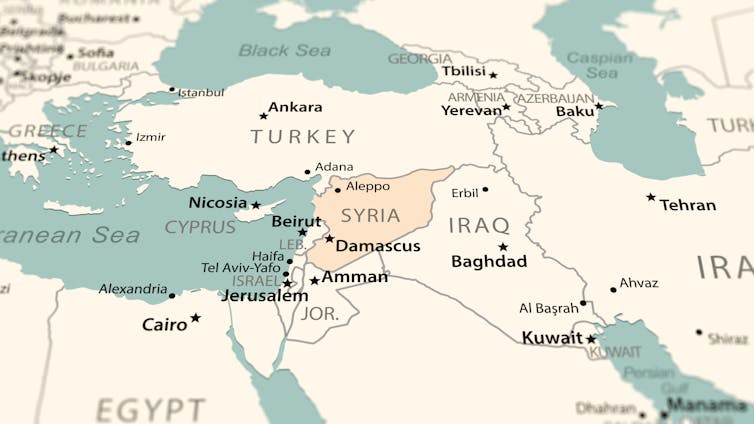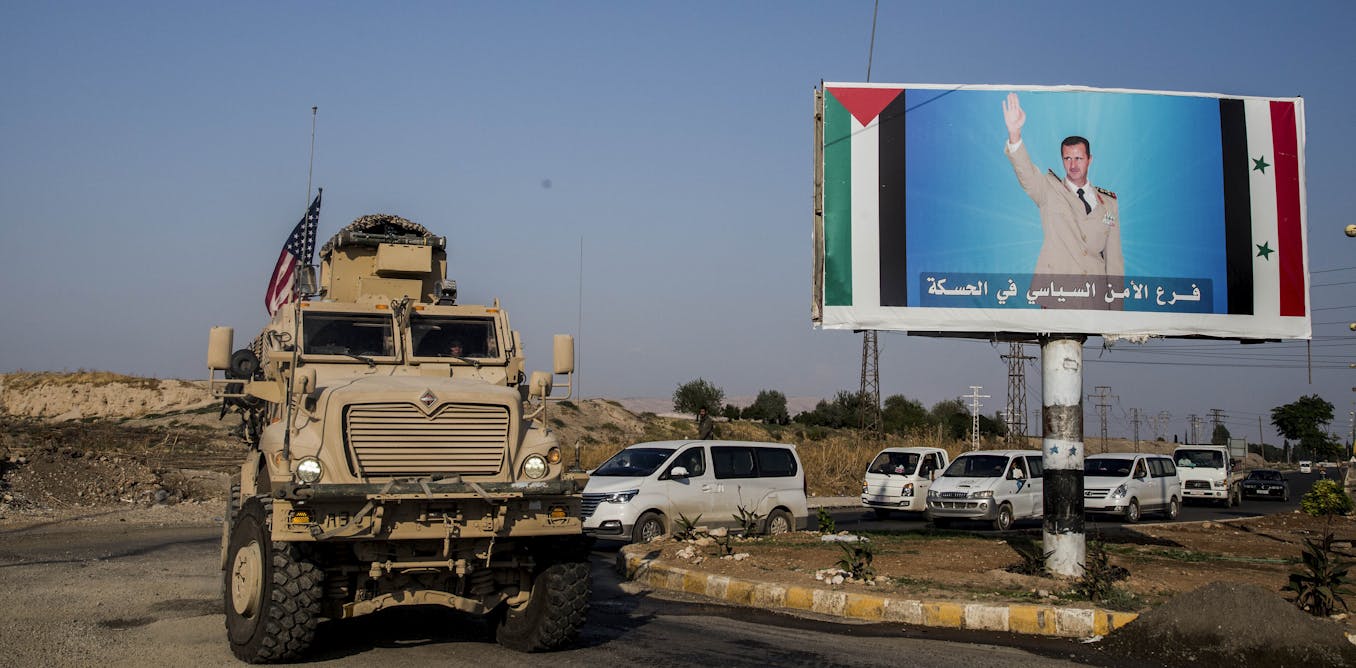U.S.-backed forces in eastern Syria launched a major attack on three posts manned by pro-government gunmen on Aug. 12, 2024, killing at least 18 fighters in a rare provocation near the border with Iraq.
The assault marked the worst clashes in eastern Syria in nearly a year. Earlier in August, eight U.S. personnel stationed in Syria were injured in a drone attack purportedly carried out by Iranian-backed militants.
These incidents highlight a fact that is often forgotten: The U.S. still has an active presence in Syria. The Deir ez-Zor Military Council behind the Aug. 12 attack is part of the Syrian Democratic Forces – a Kurdish-led alliance that has been a major U.S. partner in Syria. The group and its local affiliates now control much of the territory that the terrorist Islamic State group once controlled.
And as of the beginning of 2024, the U.S. still had close to 1,000 military personnel in the eastern part of Syria. Recent reports suggest that amid the growing tension in the region, additional resources and soldiers have made their way to the civil war-torn country.
U.S. troops in Syria serve various purposes: helping prevent the resurgence of the Islamic State group, supporting Washington’s Kurdish allies and containing the influence of Iran and Russia – both of which also have a military presence in Syria.
But the costs and risks associated with this indefinite U.S. involvement could be significant. A continued presence risks prolonging America’s entanglement in a protracted and costly conflict with no clear end in sight, while antagonizing NATO ally Turkey, which views Syria’s Kurdish groups as a cross-border threat.
As an expert on Middle East security, I focus on the evolving geopolitical landscape and argue that the U.S. must carefully weigh its commitments in Syria against the broader goals of regional stability and its relationships with allies and adversaries alike. Ultimately, whether the U.S. decides to stay or withdraw, the decision will have profound implications for Syria as well as for regional and global actors involved in the country’s ongoing civil war.
Growing US engagement
U.S. involvement in the Syrian civil war is a complex story. Shortly after the civil war began in 2011, the Obama administration placed sanctions on Syrian President Bashar al-Assad and supported factions of the opposition.
However, the administration was largely indecisive about when, how and to what extent it should intervene against the Assad regime. In part, this reflected growing war-weariness among the American public following a decade of engagement in Afghanistan and Iraq. Meanwhile, Washington struggled at first to find reliable partners on the ground in Syria.
AP Photo/Darko Bandic
As popular protests grew into a full-scale military conflict in 2012, President Barack Obama declared that the use of chemical weapons would be a “red line” for the U.S. The following year, the Syrian military did just that, deploying chemical weapons during an attack on Ghouta, a rebel-held area, resulting in the deaths of an estimated 1,500 civilians, including more than 400 children.
Yet the Obama administration hesitated to involve the U.S. militarily in the conflict, fearing escalation due to increasing Russian and Iranian support for the regime.
The U.S. military involvement in Syria began in September 2014, when a U.S.-led coalition, including the United Kingdom, France, Jordan, Turkey, Canada, Australia and others, launched an air campaign against the Islamic State group and fellow radical group al-Nusra Front inside Syria.
Following the airstrikes, American troops entered northeast Syria to back a Syrian Kurdish force known as the People’s Protection Units, or YPG, and later the Syrian Democratic Forces, an umbrella group that consists of majority Kurdish and other ethnic and rebel groups.
The U.S. did not take direct military action against the Assad regime until April 2017, when the Trump administration launched a missile strike on Shayrat Airbase in response to a suspected chemical attack in the town of Khan Shaykhun in Idlib province.
In December 2018, President Donald Trump ordered the withdrawal of the 2,000 to 2,500 U.S. ground troops in Syria, believing the coalition’s operations against the Islamic State group had been largely successful and that the U.S. presence in eastern Syria was unnecessary.
However, instead of a total withdrawal, the U.S. announced that a contingency force would remain indefinitely.
Military presence today
As of 2024, around 900 U.S. soldiers, along with an undisclosed number of contractors, are operating in Syria, according to the Defense Department. Most U.S. forces are deployed in northeast Syria in support of the Syrian Democratic Forces, with some supporting the Free Syrian Army at the al-Tanf garrison in southeast Syria, along a transit route between Iraq and Syria used by both Islamic State group fighters and Iran-backed militias.

Getty Images
But U.S. military support for Kurdish groups in Syria has angered its NATO ally Turkey, which views the YPG as an offshoot of the Kurdistan Workers’ Party (PKK), a designated terrorist organization.
Prioritizing Turkey’s security concerns, the Trump administration ordered all U.S. forces to withdraw from Rojava in early October 2019 ahead of a Turkish incursion into the region. But the move also damaged the U.S. alliance with the Syrian Democratic Forces.
Meanwhile, to appease their Kurdish allies, U.S. troops repositioned to eastern Syria, reinforcing their presence in the al-Hasakah and Deir ez-Zor governorates – two Syrian Democratic Forces-controlled regions of Syria that are rich in oil and gas.
What an American withdrawal could mean
The U.S. military presence currently serves three purposes.
First, its presence in northeast Syria acts as a deterrent to military incursions by either the Syrian regime or Turkey into the Autonomous Administration of North and East Syria (AANES). If U.S. forces were to withdraw, the Syrian Democratic Forces, which acts as the AANES’ de facto military, would need to negotiate the region’s autonomy with Turkey and the Syrian regime, both of which have made their opposition to Kurdish autonomy very clear.
Recent rapprochement attempts between Turkey and Syria have also fed Kurdish fears that a complete American withdrawal would tip the balance of power in divided Syria against them, risking their very survival.
Second, the U.S.’s presence in southeast Syria puts pressure on neighboring Iran, whose influence the U.S. seeks to limit in the region. The U.S. presence also serves as a counterbalance to Russian influence and ambitions in Syria and the Middle East. Notably, Russian airstrikes in 2015 over opposition-held areas of Aleppo and the bombing of hospitals were crucial in helping Assad regain territory and stay in power.
Third, the U.S. and its local partners have reportedly detained around 5,000 Islamic State group fighters and 50,000 indoctrinated family members. If these detainees were freed by any authority, the group could be reconstituted and grow. Underscoring the threat, the U.S., along with the Syrian Democratic Forces, thwarted a major prison break by Islamic State group fighters in early 2022.
Nonetheless, continued U.S. presence in Syria is not assured. In 2023, Republicans in the House attempted to force the Biden administration to withdraw the remaining troops. They failed. But Trump, again the Republican presidential candidate in 2024, has made it clear that he sees no role for the U.S. in “endless wars.”
Meanwhile, a U.S. troop pullout, despite the consequences, has precedence. The Biden administration withdrew all American troops from Afghanistan in 2021 and is formally transitioning to an advisory role in Iraq.
But for the time being, U.S. military presence in Syria continues and is emblematic of the broader challenges facing American foreign policy in the Middle East. The decision to stay or withdraw is a strategic one that will reverberate across the region.




